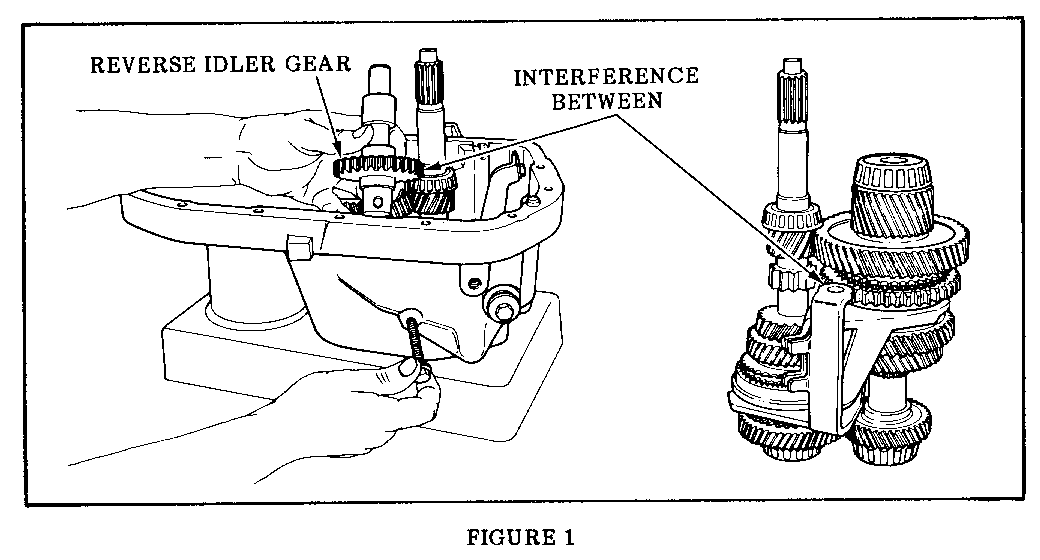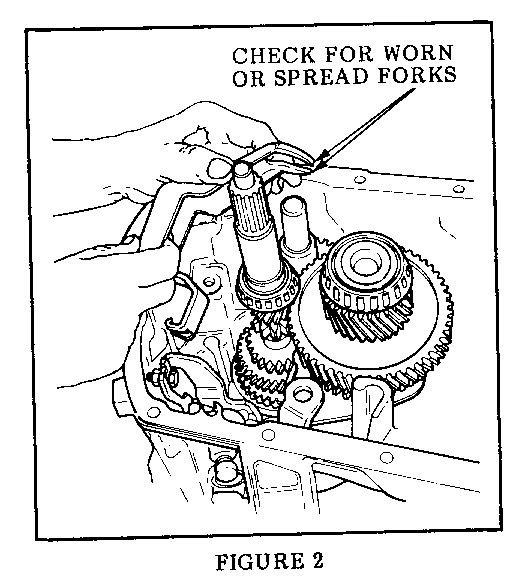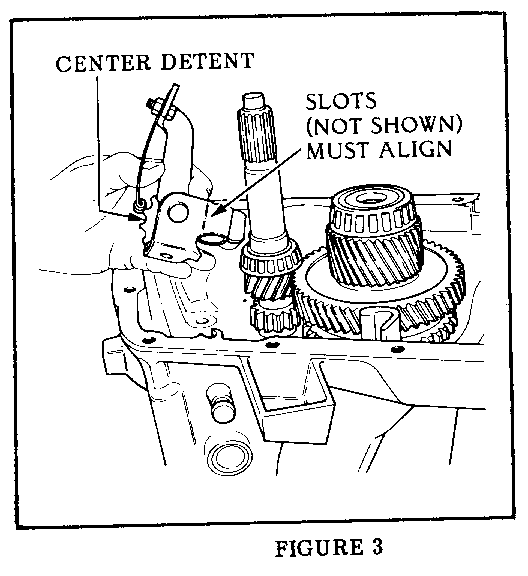INCOMPLETE 1ST GEAR ENGAGEMENT NOISE IN 2ND/HARD SHIFT/4SPEED

CIMARRON MANUAL FOUR-SPEED TRANSAXLE SERVICE INFORMATION
This bulletin provides service information for Cimarron manual four-speed transaxles with conditions of Incomplete First Gear Engagement (Section I), Noise in Second Gear (Section II) and Difficult Shifting (Section III).
I. Incomplete First Gear Engagement
1982 Cimarrons equipped with a manual four-speed transaxle may exhibit a incomplete first gear engagement condition. To correct this condition, use the following procedure:
1. Adjust shift linkage per the Service Information Manual (SIM) procedure. It may be necessary to have a second person pre-load the shifter lever in first gear while the adjustment is being made. This is accomplished by holding the shifter as far up into the first gear position as possible while maintaining a force on it toward the driver's side of the vehicle. It may also be necessary to "fine tune" the adjustment as described in the Cimarron Service Information Manual.
2. If shifter adjustment does not correct the condition, follow SIM procedures to remove and disassemble the transaxle.
3. Closely examine the 1-2 synchronizer and blocker ring as well as the first speed output gear assembly. Imperfections may not be readily evident. Replace both synchronizer (P/N 14062629) and blocker ring (P/N 464835) if there is any doubt concerning the condition of either. If necessary, also replace the first speed output gear assembly (P/N 14008270).
4. Install shims on input shaft using instructions for Kent-Moore tool (J-33373), except for shim size. Select a shim 2 classes smaller than the maximum size accepted by the Kent-Moore tool. This will reduce pre-load on the input shaft and facilitate first gear engagements.
5. Check end play on input shaft per SIM procedure. In the unlikely event that excessive end play is observed (greater than .004-.005 inches), increase the input shaft shim by one size class.
For warranty purposes, use labor Operation Number K1020 at .3 hour for step 1, or K3100 at 3.7 hours for steps 3-5.
II. Noise in Second Gear
1982 Cimarrons equipped with a manual four-speed transaxle may experience a metallic tapping or ticking noise condition (like a stick being dragged over a picket fence) during second gear operation. The condition can occur during a left-hand turn and/or straight ahead, heavy acceleration of the vehicle. Movement can also be felt in the shifter lever during the noise condition.
The noise condition is created by interference between the reverse idler gear and output first and second gear sychronizer assemblies (refer to Figure 1) and can be caused by any of the following:
1. A misadjusted shift cable or shifter mechanism that can cause an overshift condition in second gear.
2. A reverse shift lever (P/N 14008271) with an incorrect profile or spread forks (refer to Figure 2) that causes the reverse idler gear to be positioned toward the sychronizer assembly.
3. An interlock assembly (P/N 14030805) that is mispositioned or mismachined (refer to Figure 3) causing the reverse lever to move the idler gear toward the sychronizer assembly.
When servicing, perform the shift cable and control adjustments before replacing the necessary part(s). Bench test the transaxle assembly to assure the interference is eliminated before reinstalling the case cover as follows:
A. Place transaxle in second gear.
B. Lift idler gear to remove excess slack.
C. Rotate the input shaft clockwise and listen for any noise that would indicate an interference exists.
For warranty purposes, use labor Operation Number K1020 at .3 hour for step 1, or K3100 at 2.9 hours f or steps 2 and 3.
III. Difficult Shifting
1982 Cimarrons equipped with a manual four-speed transaxle may experience conditions of difficult shifting caused by worn shift forks (both 1-2 and 3-4). This condition is caused by the shift fork groove surface finish in the synchronizer assembly. To correct this condition, new synchronizer assemblies have been released which incorporate a smoother surface finish in the shift fork groove. The part numbers are:
1-2 Synchronizer Assembly P/N 14062629 3-4 Synchronizer Assembly P/N 14062631
When servicing worn shift forks, replacement of both shift forks and synchronizer assemblies together is mandatory. While the old synchronizer assemblies may appear reusable, the shift fork groove in the synchronizer can contain microscopic burrs and may cause the worn shift fork's condition to recur.
For warranty purposes, use labor Operation Number K3100 at 4.8 hours.



General Motors bulletins are intended for use by professional technicians, not a "do-it-yourselfer". They are written to inform those technicians of conditions that may occur on some vehicles, or to provide information that could assist in the proper service of a vehicle. Properly trained technicians have the equipment, tools, safety instructions and know-how to do a job properly and safely. If a condition is described, do not assume that the bulletin applies to your vehicle, or that your vehicle will have that condition. See a General Motors dealer servicing your brand of General Motors vehicle for information on whether your vehicle may benefit from the information.
